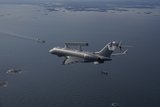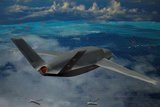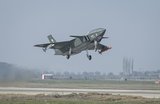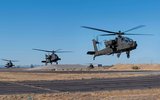First donated F-16s arrive in Ukraine but more pilot training will be ‘critical’
The Lockheed Martin F-16 Fighting Falcon will not turn the tide of the Ukraine invasion on its own.(Photo: Wikimedia Commons/Staff Sgt. Cherie A. Thurlby)
Ukraine has taken possession of the first of the F-16 fighter planes donated to the country in 2023. Shortly after the initial invasion of the country by Russian forces, President Volodymyr Zelensky made international appeals for aircraft to help the country turn the tide of the war.
Denmark and the Netherlands were the first to respond with pledges of “surplus” Lockheed Martin F-16s. Almost a year later they have finally begun their service in the Ukrainian Air Force.
These first F-16s are modernised versions of the standard supersonic F-16, and while Ukrainian pilots have already begun using them in the defence of their country and the fightback against Russian aggression, 29 months into the attritive incursion, President Zelensky told reporters the country did not currently have enough pilots who were skilled in flying such machines.
With AIM-9 infrared-guided dogfighting missiles and radar-guided AIM-120s, there is more to flying these modern F-16s than just navigation and handling, which could prove to be a problem in terms of putting the F-16s to use. Until a year ago, the country only had a fleet of fixed-wing combat aircraft, including the Su-24, Su-25, Su-27 and MiG-29. That fleet had been serving as the Ukrainian air defence for more than two decades.
The Ukrainian Air Force has also lost almost half of its aircraft since Russia’s invasion in October 2022. The newly-delivered F-16s may be powerful machines compared to the rest of the Ukrainian fleet, but the level of impact they can make to such a depleted air force given a significant shortage of trained pilots remains to be seen.
It is likely the F-16s, which themselves have been in service for decades, will be put to use intercepting Russian missile strikes, attacking Russian air defences, and potentially attack Russian ground troops and ammunition with air-to-surface missiles.
But ironically, by virtue of outclassing the rest of the Ukrainian Air Force in speed and armaments, there is an argument against using the F-16s in open combat. For one thing, they will be up against the more modern Russian S-300 and S-400 mobile surface-to-air missile systems which can pick off multiple aircraft at a time. And for another, the risk of allowing Vladimir Putin the optics of shooting down F-16s donated by NATO countries while they fly over a non-NATO country will not be one the Ukrainian President will want to take lightly.
What could make a more significant difference is an increased volume of F16s and other donated aerial systems coming into the combat zone over the remainder of 2024. The first aircraft were donated by Denmark and the Netherlands. Belgium and Norway are likely to make good on their promises to deliver more F16s by the end of the year, up to a total of around 60 aircraft. That will effectively replenish all the fighters Ukraine has lost so far in the war, but with significantly faster, more heavily armed aircraft.
The crucial factor that will determine how effective the F-16s are in the war will be increasing the number of F-16 qualified pilots that can make use of the aircraft – as and when they become a genuine commodity in Ukraine’s fightback.
Related Programmes in Defence Insight
More from Air Warfare
-
![Airbus MQ-72C Lakota Connector progress on track ahead of pending USMC decision]()
Airbus MQ-72C Lakota Connector progress on track ahead of pending USMC decision
The MQ-7C uncrewed aircraft is currently undergoing further internal flight tests ahead of a government test event anticipated for next year.
-
![November Drone Digest: GA-ASI eyes Middle East for Gambit, Edge Group unveils new UAVs]()
November Drone Digest: GA-ASI eyes Middle East for Gambit, Edge Group unveils new UAVs
In November 2025, GA-ASI unveiled a new Gambit variant, the Gambit 6, and appears to be pitching the aircraft series to various customers in the Middle East, which is a fast-emerging CCA market. The Dubai Airshow also saw the unveiling of various Emirati aircraft from Edge Group.
-
![Baykar’s Kizilelma drone makes progress with first air-to-air kill]()
Baykar’s Kizilelma drone makes progress with first air-to-air kill
This test is the latest milestone achieved by the indigenous drone, destroying a target using a beyond-visual-range missile.
-
![Lockheed plans further solid rocket motor investment in Europe and Middle East]()
Lockheed plans further solid rocket motor investment in Europe and Middle East
The company has worked to heavily invest in its solid rocket motor production capabilities, both in the US and internationally, to build a strong supply chain to meet growing demand.
-
![Boeing to build Apache AH-64E attack helicopters for Poland, Egypt and Kuwait]()
Boeing to build Apache AH-64E attack helicopters for Poland, Egypt and Kuwait
The $4.7 billion international order for the three countries will see production conclude around May 2032.
-
![How the US Air Force plans to use data analytics to enhance the roles of airmen and assets]()
How the US Air Force plans to use data analytics to enhance the roles of airmen and assets
The USAF has allocated nearly US$500 million to further the deployment of this type of technology in FY2026. It envisions using analytics to enhance sensors, weapons, missiles and human performance.
























